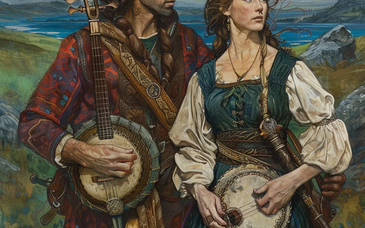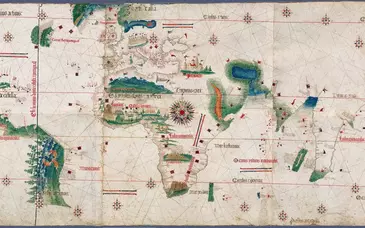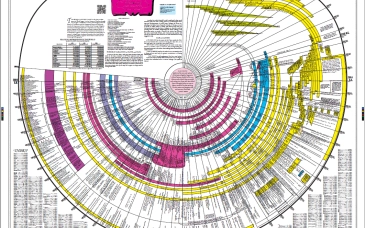Timelines: the development of (Western) Christianity, the emergence of Christian Scriptures, and the history of Biblical manuscripts, interpretation, and authority
Dr. Charles Ess, Drury University
| Approximate date/s | Event / Period | Bible reference / concept / source |
| 20's C.E. | Jesus and his followers - "a renewal movement within Palestinian Judaism" (Meeks, 88) | (Gospels) |
| 27 C.E. | Crucifixion | |
| 30-50 C.E. | Jewish Christians use Septuagint as Scripture "Oral Period" - development of the churches, oral transmission of Christian story (perhaps three distinct traditions: Jesus' Aphorisms and Parables; stories about Jesus; and primitive Christian Gospel) | (Acts) early Christian communities marked by "experiential authority" of Holy Spirit (Acts 2) --> radically egalitarian arrangements concerning gender, property, authority, etc. + pluralistic communities (diverse communities / diverse stories) |
| 50-70 C.E. : | First Christian Writings: hypothetical / lost texts -- original Gospel of Thomas "Q" (Quelle) Signs | |
| ??? | Jude as author? | Jude (perhaps the earliest writing in the Christian Scriptures; derives from Palestinian Christianity) |
| 50-150?? | Gospel of Thomas (non-canonical) (Nag Hammadi) | |
50 53 (62?) 48? mid-50's? 54 54-56 58 | Paul's letters (written while imprisoned) (the tension between Jewish Christians and Gentile Christians: emerging "Christianity" shifts from Hellenic Jewish Christians of Judea, Samaria, and Galilee [Nazarenes, Ebionites] to Gentile Christians.) [Ebionites, Nazarenes survive through 400's.] "to Gentiles who ignore the law" (Barr, 106) | I, II Thessalonians Philemon, Philippians Galatians I Corinthians II Corinthians Romans |
| 64 | Nero's persecution of Christians | |
| 65-70 | Roman war against the Jews, the destruction of the Temple in Jerusalem | |
| late 60's | Gospel of Mark | |
| 80's | Jewish Christians expelled from synagogues in some places (HarperCollins, 2011) - but some Christians continue to meet in synagogues as late as 400's (Meeks, 88) | |
| 80-90 | (break between Jewish-Christians / Christian Jews and Pharisaic Judaism - in contrast with Rabbinical Judaism, etc.) | Gospel of Matthew (written by a Jewish Christian - HarperCollins, 1858) |
| 90/100 | Council of Jamnia establishes canon of Hebrew Bible (Palestinian canon - excludes Apocrypha) - vis-a-vis Jewish Christian/Gentile use of Septuagint (Greek translation of Hebrew Bible, including Apocrypha) | |
| last 1/3rd of 1st ct. | Luke-Acts (each fills 1 papyrus roll of 31, 32 feet) | |
| after mid-60's // last 3rd of 1st ct. | Pauline Epistles - attributed to Paul, but differ from Paul's letters in important ways, e.g., the status of women (1st Generation and Paul - women as [close to] equals of men: Pauline - women as subordinate to men; the character of church (Paul - organic, egalitarian body: Pauline - hierarchical structure with defined offices); and the nature of faith (Paul - personal encounter: Pauline- doctrinal orthodoxy); --> reflects increasing effort to interpret Christ, Christian experience in Gentile terms // correlative marginalization of Jewish Christians, rejection of Gnostics, challenge to ascetics (Barr, 184) | Colossians Ephesians I, II Timothy Titus |
| 60 <--> 95 | anonymous sermon | Hebrews |
| --> 70 | James as author? | James accepted by Alexandria, 3rd ct., Syrian church, 5th ct. (contradicts Paul's teaching on justification by faith) |
| 70 <--> 90 | unknown | I Peter |
| 80-90 | unknown | II Peter |
| late 1st ct. | (persecution of Christians - perhaps via Roman authorities) | Gospel of John Revelation to John |
| ca. 100 | (writer of Gospel of John? author of 2,3 John?) | 1 John 2, 3 John |
| late 1st/early 2nd ct. | Shepherd of Hermas, popular early Christian text - ultimately not included in Christian canons (see Osiek) Gospel of Mary (Magdalene) (non-canonical) use of codex (leaf-form of papyrus book) comes into use in the church; allows binding all four Gospels together, all Epistles of Paul. Gentile Christians adopt the codex-form for their Scriptures to differentiate Church from Synagogue, which used scrolls (Metzger, 6) | |
| ca. 100-150 | p52 fragments of Gospel of John (Metzger, 39) Secret Book of James (non-canonical, Nag Hammadi) | |
| ca. 140 | Marcion (Gnostic) establishes first canon list of Christian Scripture | rejects Jewish Scriptures entirely, omits references to Jews in the versions of Luke and Paul's letters he endorses (see table, attached, from Hoover) |
| 100-200 | Thomas infancy gospel (non-canonical) | |
| ca. 150 | James infancy gospel (non-canonical) Dialogue of the Savior (non-canonical, Nag Hammadi) | |
| ca. 165 | Diatessaron ("one through four" -Tatian attempts to create a single gospel by combining, harmonizing what becomes the canonical four) |
| ca. 185 | Iranaeus cites from 22 books as authoritative) | (includes the Shepherd of Hermas, excludes Hebrews) |
| 175-225 | p75 earliest known copy of Luke, one of the earliest of Gospel of John (Metzger, 41) | |
| ca. 200 | Muratorian canon - apparently written as polemical response to Marcion's challenge | (omits Philemon, Hebrews, James, 1,2 Peter, 3 John: includes Wisdom of Solomon, Apocalypse of Peter ) |
| ca. 200 | p46 ten Epistles of Paul; excludes the Pastoral Epistles. (Metzger, 37f.) p66 fragments of Gospel of John (Metzger, 39f.) | |
| ca. 200-250 | p45 fragments of four Gospels, Acts (Metzger, 37.) | |
| ca. 250-300 | p47 middle portion of Revelation (often shows "a remarkable independence" from the codex Sinaiticus - Metzger, 38) | |
| ca. 200-300 | p72 earliest copy of Jude, Peter 1,2 (along with other works now considered apocryphal: Metzger, 40f.) | |
| 306 | Synod of Elvira prohibits eating, marriage between Christians and Jews | |
| 313 | Edict of Milan: Constantine establishes official toleration of Christianity | |
| 321 | Constantine decrees SUNday as official Roman-Christian day of rest | (indication of Roman incorporation of Christianity) |
| ca. 325 | Eusebius' canon list | uses three criteria: 1) historical - have the writtings been used by earlier generations? 2) literary - style consistent with documents known to be written early? 3) theological/doctrinal - consistent with established Church views? (see Hoover, 46f.) |
| 325 | Council of Nicea | establishes Nicene creed as statement of orthodoxy - does not address question of canonical writings |
| ca. 331 | Constantine requests 50 copies of sacred Scriptures from Eusebius --> codex Sinaiticus, B codex Vaticanus? | |
| ca. 350 | codex Sinaiticus - Old Testament, complete New Testament (Metzger, 42-6). B codex Vaticanus - both Testaments + Apocrypha (except Maccabees - Metzger, 47f.; of "undisputed precedence" as a textual authority for the Gospels - Nestle-Aland, 11) | |
| 367 | Athanasius' festal letter, defining canon of Christian Scripture in Catholic Church [prior to split between (Western) Roman Church and (Eastern) Greek Church in 1054] | "political accomodation" that includes both Hebrews (contested by Western churches) Revelation (contested by Eastern churches)? "Palpable evidence of the unity of the church... publication [of Constantine's Bibles] also symbolized the unity of the empire." (Hoover, 47) |
| late 4th ct. | W includes Gospels in "Western" order [Matthew, John, Luke, Mark], plus insertion in Mark (Metzger, 56; noted in New Jerusalem Bible, HarperCollins) | "debate" between Augustine, Chrysostom regarding freedom, sin: Augustine's doctrine of Original Sin overturns earlier, more egalitarian, Christianity, helps establish "imperial Christianity" as religion of the Empire --> cements hierarchical arrangements of Catholic Church (associated with literacy, in contrast with the "orality" of 1st generation Christian communities.) |
| 405 | completion of Jerome's translation of "the Bible" into Latin - the Vulgate: separates out Apocrypha based on comparison between Hebrew canon and Septuagint - but includes Apocrypha nonetheless. The Vulgate is the Bible for the Western (Roman Catholic) church until 1500's. | |
| 400's | A codex Alexandrinus (Metzger, 46f.) C codex Ephraemi (Metzger, 48f.) Peshitta - Syriac (eastern) version of New Testament | (Christians destroy the library of Alexandria, the last repository of "pagan" [Greek, Roman, etc.] science, literature, philosophy, in the West) (lacks 2 Peter, 2,3 John, Jude, Revelation) |
| 800/900 | MS.33 "Queen of the Cursives" - Alexandrian text, showing influence of Koine or Byzantine: complete NT - except the Book of Revelation (Metzger, 62) |
| 1200's | MS. 2053 Book of Revelation + Oecumenius' commentary (along with A, C, , the most significant source for Revelation - Metzger, 65) | |
| 1380-1397 | John Wycliffe prepares first English translation of the Bible | |
| 1450/1456 | First printed edition of the Bible (Jerome's Latin Vulgate, Mainz) | (shift from manuscript, more "oral" culture of Medieval world, to print culture of 1450---?) |
| late 1400's/early 1500's | MS. 61 First Greek manuscript containing I John v.7-8 --> compelled Erasmus to insert "this certainly spurious passage" into what became the Textus Receptus used for the KJV (Metzger, 62, 101f.) | |
| 1514 | First printed Greek New Testament ("Complutensian Polyglot") | |
| 1515-1516 | First printing of Erasmus' Greek New Testament | |
| 1522-1534 1526-1535 | Luther translates Bible (NT first) into German William Tyndale's English translations of NT Protestants omit Apocrypha from their Bibles - in part because the Roman Catholic Church used apocryphal works to justify doctrines rejected by the Protestants (doctrine of Purgatory, efficacy of prayers and Masses for the dead - warranted by 2 Maccabees 12.43-45) | (availability of printed Bibles in the vernacular fuels Protestant Reformation -- including doctrines of "priesthood of all believers," the capacity of each individual to interpret the text for him/herself --> transformation of Bible from a source of texts read and interpreted in community to a text read privately. |
| 1527 | Erasmus' 4th edition of Greek New Testament | "...rests upon a half-dozen minuscule manuscripts. The oldest and best of these manuscripts (codex I, a minuscule of the tenth century, which agrees often with the earlier uncial text) he used least, because he was afraid of its supposedly erratic text! [....] "...this debased form of the Greek Testament," achieved such pre-eminence as to become called the Textus Receptus of the New Testament: it "resisted for 400 years all scholarly efforts to displace it in favour of an earlier and more accurate text." (Metzger, 102f.) |
| 1535 | Tyndale burned at the stake for supporting Luther's heresies First complete English Bible, Miles Coverdale (based on Tyndale, Luther, Zwingli) | |
| 1582/1609/1610 | Roman Catholic English translations - Douey-Rheims Bible | |
| 1611 | King James Version | |
| late 1600's | Rise of Enlightenment optimism regarding the role of reason Thomas Hobbes (English), Isaac de la Peyrère (French Calvinist), Baruch Spinoza (Dutch Jew) publish critical analyses rejecting Mosaic authorship of the Pentateuch (Friedman, 20) | |
| 18-19th ct. | Development of the Documentary Hypothesis regarding the diverse sources of Pentateuch | |
| 19th ct. | emergence of historical-critical approaches to Biblical studies --> reaction of fundamentalism (declaring the inerrancy of the Bible [KJV] as literal word of God: cf. declaration of papal infallibility by Vatican Council I (1869-1870) | (both historical-critical approaches, fundamentalism, presuppose the existence of printed texts - i.e., they are artifacts of literacy in general and print culture in particular) |
| 1943 | Pope Pius XII's encyclical Divino Afflante Spiritu | "the Magna Carta for biblical progress" (Friedman, 27): "Let the interpreter then, with all care and without neglecting any light derived from recent research endeavor to determine the peculiar character and circumstances of the sacred writer, the age in which he lived, the sources written or oral to which he had recourse and the forms of expression he employed." |
| 1946/1952/1957 | Revised Standard Version | (Anglo-American - incorporates new scholarship in determining text, interpretations) |
| 1961/1970 | New English Bible | (English - Anglican) |
| 1966 | New American Bible | (Roman Catholic) |
| 1971 | Living Bible (based on 1901 American Standard, a revision of KJV) | (paraphrase, favored by theologically conservative communities) |
| 1973 | Common Bible - approved for Protestant, Roman Catholic, Greek Orthodox | |
| 1973/76 | New International Version | (paraphrase, favored by theologically conservative communities) |
| 1988 | Tanakh: the Holy Scriptures. | (New translation of Hebrew Bible by Jewish Publication Society, according to the traditional Hebrew text) |
| 1993 | The HarperCollins Study Bible | (a project of the Society of Biblical Literature) |
| 1993 | Report of the Pontifical Biblical Commission, endorsing modern critical scholarship, condemning fundamentalism and literalism (see "The Catholic Church and Bible Interpretation") | |
| 1990's | ca. 450 English versions of the Bible (Mullins, 273) American Bible Society's Multimedia Translations Project --> A Father and Two Sons: Luke 15.11-32. (An American Bible Society Multimedia CD-ROM for Windows, 1995) Religious communities take to the Internet | (pluralism of Christian communities as they hold to diverse compilations (including/excluding the Apocrypha, etc.) and diverse translations of the Bible) "transmediation" of Biblical text into electronic media --> transformation of conceptions of Biblical authority (both fundamentalist and historical-critical) as bound to printed Bible? "secondary orality" - radical pluralism of diverse communities, of diverse and fluid "Scriptures"? |
Information drawn from:
David Barr, New Testament Story: An Introduction, 2nd ed. Belmont, CA: Wadsworth, 1





